Latest Blogs
Software Development
Ramsha Khan
Oct 30, 2025
Remote Patient Monitoring & Telehealth Platforms: Building Scalable Systems
Read More...

Remote Patient Monitoring & Telehealth Platforms: ...
Remote patient monitoring software is becoming a strategic imperative in the healthcare industry. Health systems, clinics, telehealth companies and startups alike are asking how to develop a remote patient monitoring software that scales, that stays secure, that meets both providers and patients where they are.
Let’s dive into how you can build a remote patient monitoring software system that’s future-ready, metrics-driven and designed for scale.
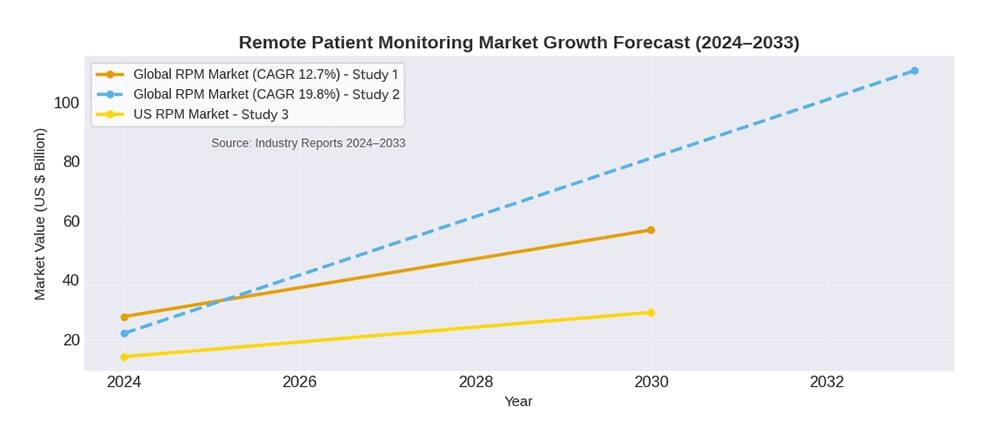
First: let’s look at the numbers. The global market for remote patient monitoring is growing at a fierce pace. According to one report, the global RPM market stood at US $27.72 billion in 2024 and is projected to reach US $56.94 billion by 2030, representing a CAGR of around 12.7%.
Another puts the market at about US $22.03 billion in 2024, with expectations to reach over US $110.71 billion by 2033, or a CAGR near 19.8%. In the U.S. alone, the value of the remote patient monitoring market is forecasted to jump from about US $14.15 billion in 2024 to US $29.13 billion by 2030.
So, if your organization (or your clients) is asking: “How do we pick the best remote patient monitoring software, or become one of the remote patient monitoring software providers ourselves?”, you’re in the right place. Let’s break it down.
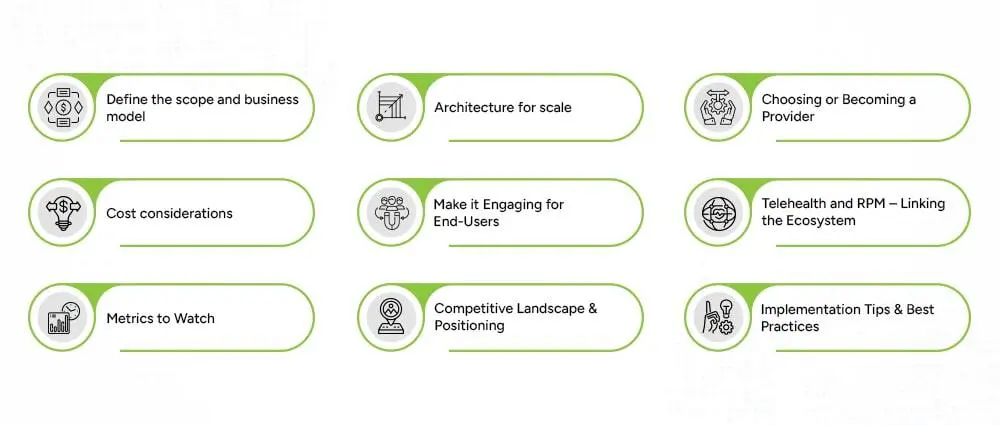
Before diving into architecture, you must answer some key questions:
What do we mean by “What is Remote Patient Monitoring”?
Put simply, RPM refers to technology-enabled care that collects patient data outside of traditional clinical settings (for example, in the home), transmits that data to healthcare providers, and allows interventions based on that data.
So, here are the questions you need to ask yourself before starting:
Writing this down early ensures that when developers ask “What features? What integrations? What scale?” you have metrics and business justifications.
When you ask: How to build a remote patient monitoring software, scale becomes a core consideration. Here’s what you’ll want to include:
You’ll want to connect to multiple devices (wearables, vital-sign monitors, implantables, home-health sensors). The more device types you support, the broader your market.
Support streaming, batch uploads, and offline data sync.
Ensure interoperability standards, HL7 FHIR, Bluetooth LE, WiFi, cellular, are addressed.
Use a cloud-based remote patient monitoring software architecture: it gives you automatic scale, geographic redundancy, and pay-as-you-go infrastructure.
Segment your services: device ingestion, data storage, analytics/AI, notification engine, user access (clinician and patient).
Apply multi-tenant design if you expect multiple clients or organisations, or enable healthcare cloud migration.
The volume of data is high. You’ll need logic that turns raw vital-sign data or symptom data into meaningful alerts, trends, risk scores.
AI/ML modules for predictive monitoring (for example, escalating risk of readmission) are becoming a differentiator in the market.
Medical data is sensitive. Compliance with HIPAA (USA), GDPR (EU), local health-privacy laws is mandatory. Use encrypted data-in-transit and at rest, secure device onboarding, role-based access control.
Audit logs, identity management, strong authentication.
EHR/EMR integration, telehealth platform connection (which brings us to telehealth vs RPM), billing/revenue cycle systems for remote care reimbursement.
If you’re evaluating existing options or looking to outsource a healthcare remote patient monitoring software developer, focus on these differentiators:
Can the system be customized for different care-pathways? If you need to develop a remote patient monitoring software for a niche (say renal care, post-surgery, chronic heart failure), flexibility is key.
Understand the remote patient monitoring software pricing: SaaS vs perpetual license, per-device/per-user, tiered usage.
Can the system handle thousands or millions of patients/devices?
Many clients prefer cloud-based remote patient monitoring software for ease of updates and remote management.
Providers increasingly want data on outcomes (reduced readmissions, improved adherence) to justify ROI.
The best remote patient monitoring software plays well with other systems meaning the healthcare interoperability between systems like EHRs, telehealth, and mobile apps.
Partnerships with device vendors, analytics companies, telehealth platforms strengthen your value proposition.
One common question: “What is the cost of remote patient monitoring software?” Cost is multi-factorial: number of patients/devices, complexity of workflows, integrations, regulatory compliance, customizations, hosting model, IT support, maintenance.
According to our expert opiion:
There’s no one-size-fits-all “price list” for “software for remote patient monitoring” or “remote patient monitoring software system” given the variations. That’s why building modular and scalable is key, it allows costs to scale more predictably.
Because, let’s be honest: technology is useful, but adoption is critical. A high-performing system means nothing if clinicians and patients don’t use it. Some tactics:
When you think of building a scalable RPM system, you’ll frequently hear the term “telehealth platforms” alongside it. While closely connected, they serve different roles. We’ll look at the difference below, but for now understand: a robust remote patient monitoring software development project will integrate seamlessly with telehealth to provide a full-care experience: data collection + virtual consultation + intervention.
Since you’re building something scalable and transactional, you’ll want to monitor these KPIs:
When you’re discussing a project or prospect for best remote patient monitoring software, these metrics help demonstrate ROI and scalability.
If you are contemplating to become a provider or choosing one that offers remote patient monitoring software, the first thing to consider is: the market is full of sellers, so it is vital to differentiate yourself:
When you mention “remote patient monitoring software providers,” these are the features that make you different from the rest.
Here are some practical tips gleaned from real-world cases:
Select a small cohort of patients, monitor data flows, clinician engagement, patient behaviour.
Patients hate complicated device set-ups. Use plug-and-play as much as possible.
New dashboards can disrupt workflows; invest in change management.
Build your compliance, privacy, consent systems from day one. Retrofitting is expensive.
Auto scaling, auto updates, logging/monitoring.
Show them trends and outcomes (not just raw device data) and build for localization and different regulatory regimes if you will scale globally.
Remote monitoring and telehealth technologies evolve fast; you want a modular code base.
Without sufficient patient engagement, your system won’t deliver value.
Device vendors, telehealth vendors, and analytics vendors often form ecosystems; join them rather than reinvent everything.
If your organization is ready to step into this space, to build a remote patient monitoring software or upgrade an existing platform, now is an excellent time. With a growing global market, increasing demand from chronic-disease care and home-care models, and telehealth becoming mainstream, your opportunity is large.
At Arpatech, we specialise in remote patient monitoring software development and can help you every step of the way: from concept and architecture to deployment and scaling. Whether you’re looking to develop a remote patient monitoring software from scratch or integrate enhanced features into an existing system, we can guide you through technology choices, cloud-based deployment, regulatory compliance, and user adoption.
Let’s build your next-generation remote patient monitoring platform together, one that delivers outcomes, scales effortlessly, and positions you as a leader among remote patient monitoring software providers.
There is no single answer, because cost depends on number of patients/devices, feature scope, integrations, regulatory complexity, deployment model (cloud vs on-premises). As noted above, for a full custom build, you might expect budgets to be on a little higher side.
On a per-patient SaaS basis, some packaged solutions may charge hundreds of dollars per patient per year. The key is to define the scope clearly and build modularly so you can add features as you scale.
Yes, from both a care-delivery and business perspective. The data shows strong growth in uptake and market size, and the ability to monitor patients outside the hospital enables lower costs, better outcomes (reduced readmissions, earlier interventions), greater patient reach.
If implemented well (with good UX, clinician buy-in, patient adherence), remote patient monitoring can provide a real competitive advantage and cost savings.
In short: telehealth is a broader umbrella term covering virtual visits, tele-consultations, remote delivery of healthcare services via audio/video. Remote patient monitoring is a subset focused on monitoring patient health data remotely (such as vital signs, device data, symptoms) outside a traditional clinical setting, and acting on insights from that data.
They work together: RPM collects the data, telehealth enables the intervention. But they are distinct in terms of workflow, requirements and technology.
Ramsha Khan
Oct 30, 2025

Edge + IoT in Smart Hospitals: Architectures for Real-T...
Hospitals are no longer just buildings with beds and corridors; they’re becoming data centers on the move. Between bedside monitors, wearable sensors, smart IV pumps, imaging devices and building systems, modern hospitals produce massive amounts of data every second. To turn that stream into immediate, actionable care we need computing where the data is born, not 1,000 miles away in a cloud datacenter. That’s where edge computing in healthcare and IoT architectures for smart hospitals step in: processing, analyzing and acting on data at the bedside or inside the hospital network for true real-time healthcare.
Today, we’ll explain practical architectures, real edge computing applications in healthcare, high-impact use cases, measurable benefits, and best practices you can adopt today, all in plain language and with two solid industry stats to anchor the case.
Imagine a cardiac telemetry monitor that detects a dangerous arrhythmia. If that monitor must send raw waveform data to a distant cloud, wait for analysis, then return an alert, valuable seconds, or minutes, are lost. Edge nodes (local servers, gateways, or even smart devices) analyze the waveform immediately, surface the alert to clinicians, and optionally send a summarized record to the cloud for archival and analytics.
That drop in latency and the ability to filter and pre-process large data streams is why Edge Computing Transformation in Healthcare is more than a buzzword; it’s a practical shift that enables real-time decisions in critical care. Edge also reduces bandwidth and lowers the exposure of sensitive data in transit, improving privacy and compliance.
A reliable smart-hospital architecture usually layers computing so each task runs where it makes most sense:

This hybrid lets you run immediate detection and automation at the edge while keeping the cloud for heavy lifting, historical analytics and cross-site intelligence.
Edge computing in healthcare unlocks a range of practical, high-value applications:
These edge computing applications in healthcare reduce noise, surface the right events, and free clinicians to act faster with higher confidence.
Market growth: Analysts estimate the edge computing in healthcare market will grow substantially, from roughly USD 6.18 billion in 2024 to about USD 38.12 billion by 2032, driven by demand for low-latency processing and real-time care use cases. This creates strong commercial incentive to adopt edge architectures.
Performance impact: Research comparing edge-enabled clinical systems shows dramatic latency and network improvements, in one study, moving analytics to the edge produced an average latency reduction of about 87.7× and improved overall network efficiency (bandwidth) by roughly 2.6×, results that matter a lot in critical workflows.
Use cases like real-time arrhythmia detection or surgical-assistance AI become possible when inference runs locally with those kinds of performance gains.
When evaluating whether to adopt an edge + IoT model, hospitals repeatedly cite a set of powerful advantages that improve clinical outcomes, operational reliability, and cost efficiency. Let’s look at each benefit in detail.
In the healthcare field, every second matters and can be the difference between saving a life or not. By utilizing IoT and edge computing in healthcare, the data of patients coming from monitors, imaging devices, or wearables is being processed right where it’s collected instead of being sent to a faraway cloud for analysis. This has the effect of cutting down latency and thus, it is almost instant that doctors and nurses get notified, patients are updated, and diagnostic results are available.
To illustrate, when the oxygen saturation of a patient drops suddenly, the edge-based monitoring system will not just sit there and wait for cloud confirmation but will instead send an alert to the medical team right away. This rapidity allows for drug adjustments, interventions, and directed responses, especially in emergency rooms, ICUs, and operating theaters, among others, to be done faster and to save lives.
Every minute, hospitals are creating huge data volumes ranging from medical imaging to IoT sensors and smart devices. All these unprocessed data are transferred to the cloud may push the network capacity to its limits and cause an increase in operational costs.
On the other hand, with edge computing, only the summaries, insights, and flagged anomalies are being sent to the cloud for storage, while the raw data is being processed and filtered right where it is produced. This scenario lessens the strain on hospital networks, cuts down on the use of bandwidth, and gives the IT teams an opportunity to manage the data more efficiently. In other words, the edge allows hospitals to smartly deal with the “data noise”, that is keeping the useful part and throwing away the rest.
Every healthcare institution puts the safeguarding of patient information as their main priority. The adoption of edge computing in the healthcare sector elevates the level of data security because it enables the processing of sensitive patient data at the local hospital, or at least very close to the point of care.
This type of processing means that the personal health information (PHI) will not undergo long travels across the internet to the remote data centers, hence the risk of interception or breaches is significantly decreased. Furthermore, it makes it easier to adhere to the strict regional data protection regulations, such as HIPAA, GDPR, or any local health data law. By ensuring that the sensitive data remains within the controlled perimeter, hospitals obtain the dual benefit of enhanced privacy and seamless compliance.
Hospitals cannot afford downtime, even a short network interruption can disrupt care delivery. Edge computing in healthcare ensures continuous operation by processing data locally, independent of external internet connectivity.
So even if the hospital’s connection to the cloud is temporarily lost, critical systems, like patient monitors, medication pumps, or diagnostic devices, continue functioning seamlessly. This built-in resiliency guarantees uninterrupted service and patient safety, making edge computing a cornerstone of high-availability healthcare IT infrastructure.
Running every application and storing every piece of data in the cloud can become expensive over time, especially with continuous data streaming from thousands of devices. By adopting an edge architecture, hospitals reduce cloud egress, bandwidth, and storage costs, since most processing and filtering happen locally.
Moreover, edge computing allows for targeted investments, hospitals can deploy high-performance edge nodes only where they’re needed most (like ICUs or surgical departments) rather than scaling cloud capacity across all systems. The result? Lower operational costs, better resource allocation, and a strong long-term ROI for healthcare organizations.
Put simply, edge computing transforms constant device chatter into meaningful, actionable insights. Instead of drowning in unfiltered data, hospitals can focus on what truly matters, faster responses, better care, and smarter decisions. With the right strategy, edge + IoT technologies make healthcare not just more connected, but also more intelligent and human-centered.
If you’re designing Edge computing applications in healthcare or planning pilots, use these practical best practices:
These are the Best practices for edge computing in healthcare that teams with successful deployments follow.
The Future of Computing in Healthcare looks hybrid and distributed. Expect:
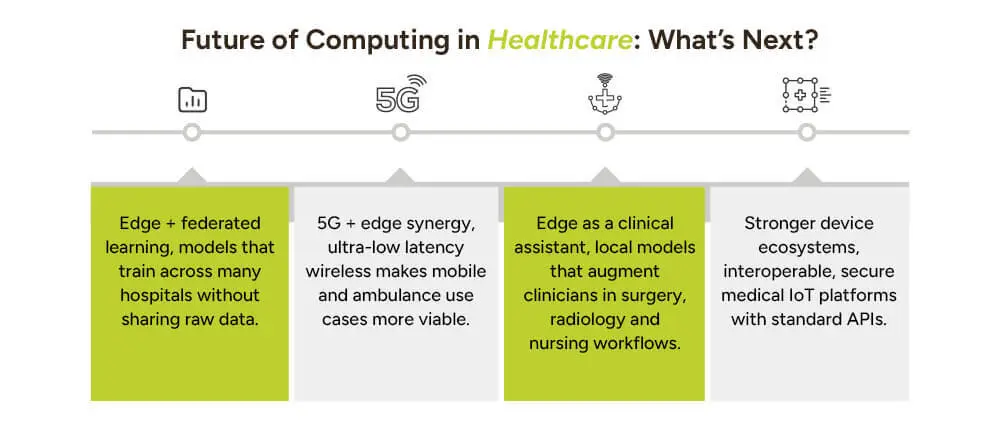
The future is less about cloud vs. edge and more about using each layer where it delivers the most clinical and operational value.
At Arpatech, we empower hospitals and healthcare providers to build intelligent, secure, and compliant edge-to-cloud ecosystems. Our team specializes in:
Whether you’re upgrading existing hospital systems or launching a smart healthcare initiative from the ground up, Arpatech Cloud provides the technical backbone and strategic expertise to make it happen faster, safer, and smarter.
Transform your healthcare infrastructure today.
Short answer: Cloud computing centralizes heavy processing, storage, and long-term analytics in remote datacenters; edge computing moves processing closer to the devices (bedside, gateway, or hospital server) so time-sensitive tasks run locally.
In practice: use the edge for real-time inference, immediate alarms, privacy-sensitive preprocessing, and to keep services running during network outages. Use the cloud for migration, training models, population-level analytics, archival storage, and cross-facility reporting. A hybrid approach, edge for speed and privacy, cloud for scale and longitudinal intelligence, is the recommended pattern for modern smart hospitals.
Ramsha Khan
Oct 28, 2025

Logistics with Custom Software: Smarter Routes, Faster ...
The logistics sector is the silent power that maintains the flow of international trade. Through various means such as warehouse management and fleet tracking, logistics companies use technology to move goods efficiently and at competitive rates. However, customer demands are changing and off-the-shelf tools are not enough as they are generally unable to provide the desired level of service. Hence, custom software development for logistics becomes crucial.
A wide range of features, including route optimization, real-time tracking, and unbroken communication between drivers and dispatchers, can be enabled by custom logistics software development, which grants unparalleled flexibility, automation, and control over business operations.
To put it simply, the development of logistics software involves the creation of digital solutions that facilitate and even manage different logistics activities, like shipment handling and delivery route optimization. Among these solutions are:
The partnership with a logistics software development company helps the customers by digitizing their workflows, improving their insights, and offering them more efficient support.
Statista data indicate that the global logistics software market will grow up to $20.4 billion in 2032. That is mainly because of the increased need for automation, visibility, and sustainability in logistics operations.
A Transportation Management System (TMS) is one of the most important components in the logistics tech stack. It’s a type of software that helps plan, execute, and optimize the physical movement of goods.
A TMS integrates data from shippers, carriers, and logistics providers, allowing companies to:
With a strong transportation software development company, you can create a TMS personalized to your unique business operations, whether that’s automating delivery schedules, tracking driver performance, or integrating IoT sensors for fleet visibility.
Modern TMS platforms can even use AI and predictive analytics to forecast delays, identify bottlenecks, and recommend the most cost-efficient shipping routes.
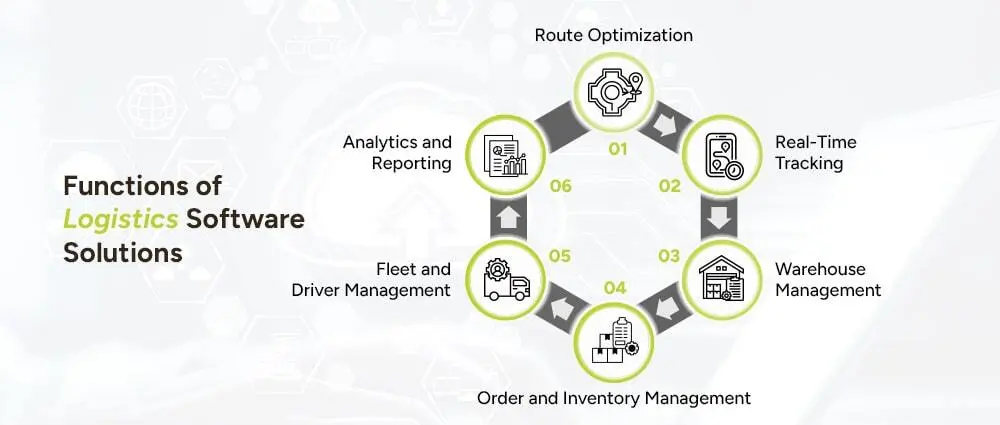
A powerful logistics software solution doesn’t just manage shipments; it transforms how your business operates. Some of the most valuable functions include:
Using algorithms and real-time traffic data, custom logistics software development helps companies plan the most efficient delivery routes, reducing fuel costs, delivery times, optimizing last-mile delivery, and reducing driver fatigue.
Using GPS and IoT, companies are able to see the movement of goods, the location of vehicles, and the performance of drivers at the same time. Also, the consumers are the ones to get the most out of the situation as they receive precise delivery times and have the chance to track the order live.
A logistics software solution can keep up with the inventory, trace each item, and send automated notifications for replenishment. This is how high productivity in the warehouse is guaranteed.
The centralized dashboards give a view of orders, returns, and stocks across various locations, which is quite helpful to ensure the proper coordination of warehouses and delivery fleets.
Watch over the health of the vehicle, the maintenance schedule, and the performance of the driver so that you can minimize the downtime and heighten the safety level.
Data-driven insights help managers identify inefficiencies, forecast demand, and make informed business decisions.
Together, these features streamline operations, reduce manual work, and deliver the agility logistics companies need to stay ahead.
Custom logistics software development investment is a decision with a lot of long-term benefits. The major logistics software advantages are the following ones:
Using smarter routing, predictive maintenance, and efficient resource distribution, companies can cut down considerably on their costs for fuel, workforce, and overall operations.
Every stage of shipment and delivery can be monitored better thanks to the transparent and data-rich insights.
Receiving updates on time, knowing the exact time of arrival, and having fewer delivery errors all contribute to greater customer satisfaction.
A centralized platform connects all stakeholders, drivers, dispatchers, and customers, ensuring seamless communication.
Custom software development for logistics, as opposed to ready-made solutions, matures alongside your business. New functionalities can be incorporated, new technologies can be integrated, and geographical expansion can take place, all without any disturbance.
To put it simply, logistic software solutions shift classic supply chains into intelligent, connected ecosystems that work with exactness and power.
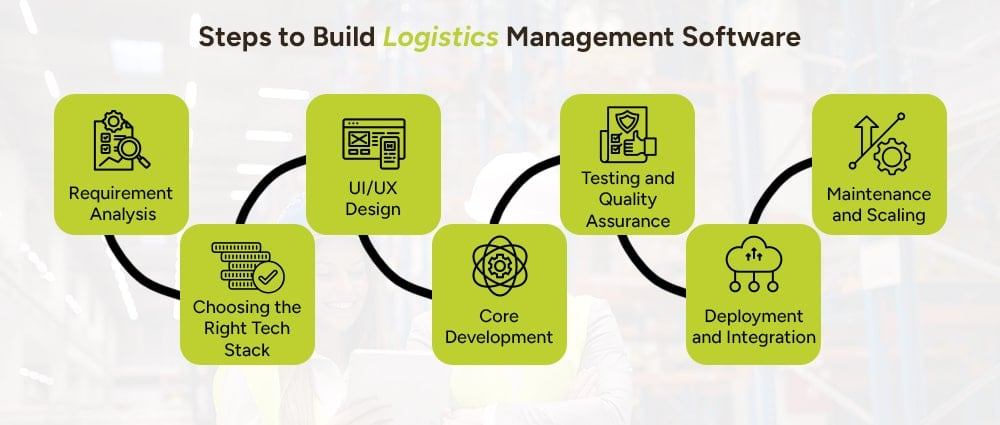
Developing logistics software involves several strategic steps to ensure it aligns with your business goals and workflows. Here’s how a logistics software development company typically approaches the process:
The first step in the process is to pinpoint your logistics difficulties, such as an inefficient route, problems with warehouse management, or no real-time tracking. Your solution will be based on these insights.
The selection of technologies suited for scalability, security, and integration with the current system is done by the developers of the transportation software company. Technologies like React, Node.js, or Python and APIs are among the selected ones.
Due to the fact that logistics operations have a diverse set of users involved, such as drivers, dispatchers, and customers, the interface needs to be very user-friendly, quick to respond, and developed for both mobile and web platforms.
During this phase, the pivotal attributes of the system are developed: route optimization, order management, vehicle tracking, reporting dashboards, and integration with third-party logistics (3PL) systems.
Thorough testing guarantees the solution’s ability to operate effortlessly even during peak times. QA experts check for correctness, speed, and user-friendliness.
After passing the tests, the software gets integrated with your logistics ecosystem, assuring interoperability with ERP systems, CRM tools, and IoT devices.
After going live, a trustworthy logistics software development service provider will keep updating your system, fixing bugs, and adding new modules as per your operations growth.
Building your own logistics management software ensures you have full control, customized to your operations and adaptable to future needs.
If you are still depending on manual spreadsheets, disconnected tools, or old systems, you are already losing productivity. Here are the reasons why logistics software development services are a must-have today:
We, at Arpatech, believe that a good logistics software development company doesn’t just build software; it builds efficiency, visibility, and trust into your supply chain.
At Arpatech, we specialize in custom logistics software development designed to simplify your supply chain operations and enhance profitability.
As an experienced logistics software development company, our team builds scalable and secure solutions tailored to your business needs. Whether you’re a logistics provider, fleet operator, or e-commerce business, we deliver:
Our logistics custom software development services focus on usability, scalability, and measurable ROI.
We also integrate advanced technologies like AI, IoT, blockchain, and predictive analytics to ensure your operations are future-ready.
Partner with Arpatech, a trusted transportation software development services provider, and let us help you optimize your routes, reduce operational costs, and create seamless logistics experiences for your clients.
Yes! The team of Arpatech specializes in the creation of logistics software based on SaaS that enables companies to handle the whole process from any location, to expand without any limitations, and to be connected with other electronic tools via APIs by the means of integration.
Any business that is somehow involved in the process of moving goods or delivering goods, such as transport companies, courier services, warehouses, e-commerce, and manufacturers, will benefit from custom logistics software.
The most popular forms of logistics software are TMS, WMS, Fleet Management Platforms, and Order Tracking Systems. Through custom manufacturing of logistics software, you can join up these functions into one integrated platform that is personalized to your requirements.
Ramsha Khan
Oct 23, 2025

Fintech in Supply Chain: Payments, Financing & Emb...
Supply chain moves the world. Every time something is made, shipped, or delivered, there’s a whole web of suppliers, manufacturers, carriers, and buyers doing the heavy lifting behind the scenes. But often what holds things up isn’t the physical transportation, but finance and payments.
That’s where fintech in supply chain comes in, bringing speed, transparency, and flexibility to get goods moving and money flowing. If you’re in the logistics, procurement, or operations world, the shift is all around you.
Today, we’ll explore how fintech is transforming supply chain payments, supply chain finance, and embedded finance in transport and logistics. We’ll also dig into real benefits, challenges, and ecosystem opportunities so you can see why fintech is the next supply chain frontier.
To understand why fintech is the next supply chain frontier, picture this: suppliers often wait 30, 60, sometimes 90 days to get paid after delivering goods. Carriers and logistics providers often face delayed invoices, confusing accessorial charges (think fuel surcharges, demurrage, etc.), and a lack of visibility when their payments will clear.
On the buyer side, companies want to hold onto cash as long as possible, but if payments are too slow upstream, that delays everything downstream.
That mismatch causes all kinds of friction:
Enter fintech: solutions that digitize, automate, finance, and embed payments and funding throughout the supply chain. When done right, Fintech’s Impact on Supply Chain Payments is massive.
Here are some of the main levers fintech is pulling in logistics and supply chain management:
Classic tools like reverse factoring or invoice financing, where suppliers can get early payment of invoices (at a discount), and buyers can extend payment terms without hurting supplier relationships. This helps both sides manage working capital better.
Moving from paper checks or manual bank transfers to electronic / API-based payments. Real-time or near-real-time payments reduce uncertainty and speed up the whole chain.
Embedding financing, payment, insurance, or credit options directly into the platforms that carriers, freight forwarders, or shippers use. For example, when a carrier completes a shipment, they can immediately get paid via a fintech service built into their dispatch or transport management software.
E-invoicing, digital dashboards, real-time tracking of payments and shipments, AI-based risk logistics scoring, blockchain or smart contracts to ensure documents and payments trigger only when certain conditions are met.
Let’s talk about the challenges with supply chain transactions and how fintech addresses them.
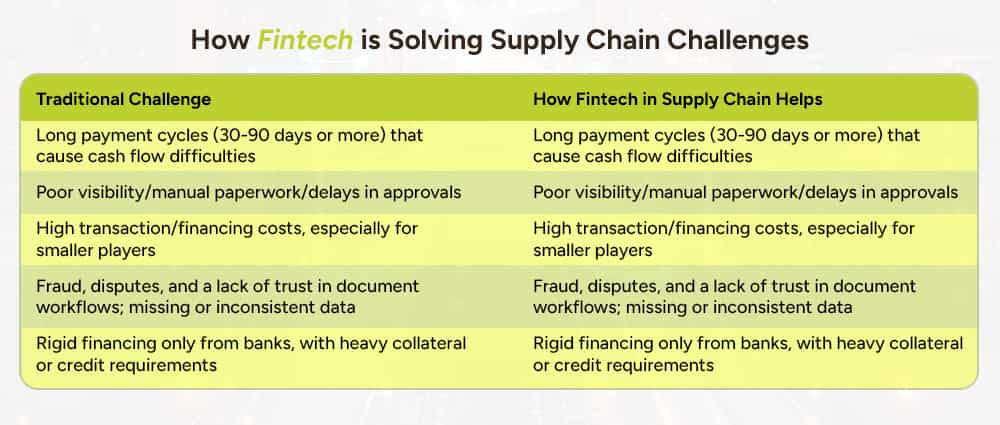
The embedded finance market was valued at US$82.7 billion in 2023, and it is forecast to reach US$570.9 billion by 2033, growing at about 21.3% CAGR.
In the logistics and wholesale trade sector, embedded finance is taking off: ~83% of PayFacs, ~80% of marketplaces and ~64% of ISVs express “strong interest” in digital wallets as part of embedded finance innovation.
These numbers show demand is high, and suppliers, carriers, and platforms see clear upside.
If you’re considering adopting fintech solutions, here are the concrete benefits that supply chains are getting:
Improved Working Capital & Liquidity: Suppliers get funds earlier; buyers can stretch out payables without hurting the supplier’s balance sheet. SCF helps optimize working capital.
Lower Cost of Financing: Because financing is often based on the creditworthiness of large buyers, or alternative risk assessments (via fintech tools), cost of capital for suppliers can be materially better than if they went to a traditional bank.
Faster, More Reliable Payments: Less lag from delivering goods to getting paid. Less uncertainty for carriers and smaller suppliers.
Greater Transparency & Visibility: Everyone in the chain can see where a payment or shipment is, what stage an invoice is at, what’s owed or due. That reduces disputes and improves trust.
Operational Efficiency & Cost Savings: Less manual work, less error, faster reconciliations. Platforms, APIs, and automated workflows reduce admin costs.
Better Relationships with Suppliers & Carriers: Suppliers like early payment options; businesses that offer embedded finance or supply chain finance tend to foster loyalty and stability in their logistics networks.
There’s a growing ecosystem of fintechs, platforms, carriers, software vendors, banks, and investors focused on supply chain fintech. Some opportunities in that ecosystem:
Putting this all together: fintech is not just a nice add-on. It’s becoming essential. Supply chains are more complex than ever, global shocks (pandemics, trade disruptions, fuel costs, geopolitical risk) show that any delay in financing or payment ripple quickly.
Fintech brings, which means it makes sure suppliers don’t go under because of delayed invoices; making sure carriers get paid so they don’t cut corners; making sure buyers can manage their cash sustainably without squeezing their network.
Also, customers (the end users) expect faster, more reliable last-mile delivery, lower costs, transparency. If logistics costs are high because of inefficiencies in payment or financing, that often trickles into end prices or delays. Fintech helps reduce those costs and delays.
So, for businesses that are still relying largely on manual, paper-based, or very traditional payment and financing systems, the risk is falling behind. Those embracing fintech will be more agile, more competitive, more trusted.
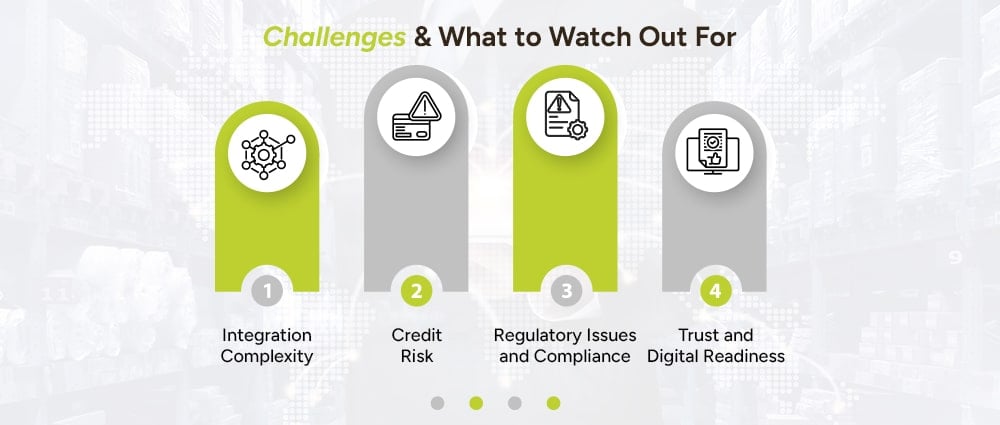
Of course, fintech doesn’t magically fix everything. Some of the challenges with supply chain transactions and supply chain fintech include:
Connecting Systems (ERP, shipping, invoicing) across buyers, suppliers, and logistics providers is not trivial.
For suppliers, even if the buyer is solid, finance providers need confidence; sometimes upstream suppliers further removed are harder to assess.
Cross-border payments, KYC/AML rules, data protection, financial regulations vary by region.
Cost of Adoption:
For smaller firms, platform fees, technology costs, training, may be barriers.
Some suppliers or carriers may distrust new platforms or don’t have reliable internet/data systems; paper, legacy systems are deeply entrenched.
In the next few years, expect:
At Arpatech, we help logistics and supply chain companies integrate Fintech-driven solutions, from automated payments and smart financing modules to AI-based analytics and embedded finance systems.
Whether you’re looking to streamline operations or build secure, scalable platforms, our custom software development services can help you stay ahead in the evolving Fintech landscape..
Traditional supply chain finance often struggles with:
One common example: imagine a large retailer buys from many suppliers, with payment terms of 60 days. A supplier delivers goods and issues an invoice. Rather than waiting for 60 days, the supplier has the option to use a supply chain finance platform, which pays them early (say day 5 or 10) at a small discount. Then the retailer still pays the financier on the 60th day.
So, the supplier gets cash early, the buyer maintains its cash for a longer period, and the financing provider earns a fee/discount. This helps suppliers smooth out cash flow, buyers manage working capital, and finance providers get a predictable business.
Supply chain finance is used by:
Global supply chains that include cross-border trade and many suppliers/carriers in different regions.
Technology companies/software vendors building tools to embed payments and finance within logistics, transport management, or procurement systems.
Ramsha Khan
Oct 21, 2025

RegTech & Compliance Automation: Reducing Risk in ...
Banks live in a world of rules. New laws, updated guidance, and shifting supervisory expectations arrive constantly, and when compliance slips, the fallout can be reputational, financial, and operational. Enter the Rise of RegTech Automation: a wave of technology designed to make compliance faster, smarter, and less error-prone.
Today, we’ll learn about what RegTech is, why RegTech automation matters for banks, current trends, practical use cases, and clear steps to implement RegTech and compliance automation, all in plain language.
Put simply, RegTech (regulatory technology) is the practice of using software, data tools and automation to help regulated firms meet rules and report to regulators more efficiently. Instead of copying and pasting spreadsheets or hunting for buried documents, RegTech Automation tools automate the repetitive parts of compliance.
These repetitive parts could include: monitoring rules, screening transactions, checking customer identities, preparing reports, and flagging suspicious activity. Think of it as “compliance on autopilot”, but with human oversight.
The continual transformation of regulations is a constant factor. Banks have to monitor and keep track of hundreds or even thousands of rule changes, which can be local or from different jurisdictions. Change is one of the main causes for the speed of RegTech automation development in the financial industry: companies need instruments that not only can be used for provision of regulatory updates but also can convert them into operational rules for systems and personnel.
Regulatory intelligence sources actually pointed out the number of alerts and updates that compliance teams are required to handle, and this indicates the necessity of automation.
Concurrently, the RegTech market is flooding with new entrants, which means the capability of vendors and the amount of investments are maturing so that large and small banks can easily adopt the solutions. The latest market research estimates the global RegTech market value to be in the billions, thus indicating rapid growth and strong demand.
Regtech compliance automation is the subset of RegTech focused specifically on automating the compliance lifecycle: rule ingestion, policy mapping, customer due diligence, transaction monitoring, sanctions screening, reporting, and audit trails. Good compliance automation does three things well:
Put together, these capabilities reduce regulatory risk and free compliance teams to focus on judgment-heavy work rather than rote tasks.
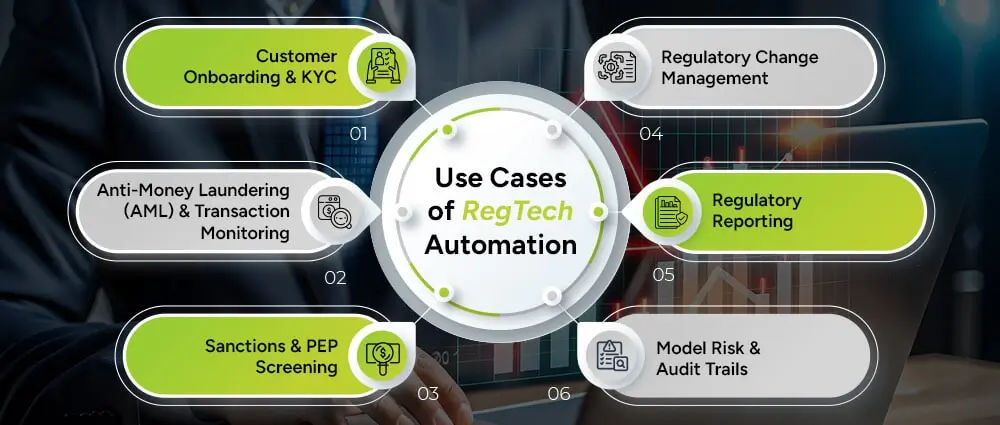
Here are some examples where regulatory technology is commonly used and you see RegTech automation in action every day:
Automated identity checks, document validation, and risk scoring speed up onboarding and reduce false positives.
Machine learning models analyze flows and flag suspicious activity for investigation.
Real-time screening against global sanctions lists and politically exposed persons (PEPs) databases using RegTech automation .
Tools that automatically ingest new rules and map them to internal policies and controls.
Automated assembly of required reports (e.g., liquidity ratios, large exposure reports) into regulator-ready formats.
Systems that version and validate compliance models and keep immutable logs for audits.
These Use Cases of RegTech Automation aren’t theoretical, banks are already deploying them to shrink investigation times and improve detection rates. Academic and industry studies report improved AML performance after adopting RegTech solutions
Here are some Regtech Trends to follow when it comes to enabling better and quicker compliance.
AI improves detection but regulators demand explainability. Expect tools that balance predictive power with transparent reasoning.
Cloud-native, subscription models lower the barrier to entry, small banks can now access enterprise-grade capabilities.
Move from batch checks to live monitoring so issues are flagged before they become breaches.
RegTech automation products are integrating with core banking systems and data lakes via APIs for smoother data flow.
Consolidated regulatory intelligence: Vendors provide curated, machine-readable regulatory updates to feed rule engines automatically.
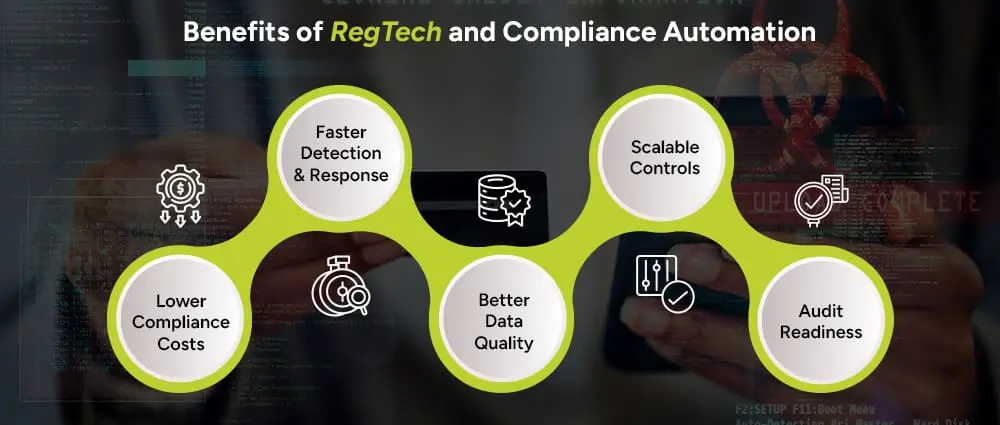
Now, let’s talk about what benefits banks are getting from using Regulatory Technology and Compliance Automation:
Automating mundane tasks reduces headcount needs for repetitive work and minimizes expensive regulatory fines.
Real-time screening means suspicious activity is investigated sooner.
Automated pipelines reduce manual errors and standardize reporting.
As banks expand into new markets, automated controls scale far more easily than manual teams.
Immutable logs and versioned rules streamline audits and regulatory requests.
These benefits compound: better detection reduces loss, fewer manual errors shrink fines, and faster reporting strengthens regulator relationships.
If your bank is considering automation in RegTech, here’s a pragmatic roadmap:
Identify the highest-impact regulatory risks (AML, sanctions, data privacy, capital reporting). Focus automation on areas with the largest exposure.
Map where the data lives, its quality, and how systems talk to each other. Automation needs clean inputs.
Prefer solutions with open APIs and modular features (screening, monitoring, reporting). This supports phased rollout and reduces vendor lock-in.
Run a small pilot against a defined use case (e.g., sanctions screening). Measure false positive rates, investigator time saved, and integration effort.
Ensure models and rules have governance: version control, validation, and human-in-the-loop review. For AI, prioritize explainable outputs for auditors.
Upskill investigators and compliance staff to work alongside automation, their judgment transforms flagged cases into decisions.
Once the pilot shows results, scale to additional products and regions while monitoring outcomes closely.
These Steps to Implement RegTech and Compliance Automation keep the program manageable and aligned with regulatory expectations.
The global RegTech market is rapidly expanding and was valued at roughly USD 15.8 billion in 2024, reflecting strong demand for compliance automation tools.
At Arpatech, we help banks turn the promise of regtech compliance automation into production value. Here’s how we work with clients:
If you want to reduce false positives, shrink investigation times, and demonstrate stronger controls to regulators, Arpatech can build a practical, stepwise program that delivers measurable risk reduction.
Regulatory pressure on banks isn’t going away. The Rise of RegTech and automation in RegTech give financial institutions the tools to meet that pressure intelligently.
When executed properly, the implementation of RegTech automation and compliance automation can lead to significant cost reductions, faster detection, improved data quality and reduction of the pain associated with audits. Start with the most risky processes, validate with pilot, and scale up, all the while maintaining explainability and governance as top priorities.
A partner, like Arpatech, with the right qualities (and a suitable roadmap) transforms compliance from a cost center into a competitive advantage.
Let’s collaborate on your next project!
Absolutely. FinTech is short for financial technology and it is the one that usually thinks about betterment of existing financial services or even the creation of new ones such as payments, lending, personal finance, trading and so on. RegTech on the other hand is the one which mainly deals with the regulatory and compliance issues and it helps banks and other institutions that are regulated to adhere to the rules, give reports to supervisors and manage the risk of regulation. There is a bit of overlap (the FinTechs often make use of the RegTech modules) but the difference in the main goal is very clear: FinTech is the one developing the financial products which are for the customers, it also offers FinTech security; RegTech is the one securing the firms and making sure that they comply.
RegTech’s role is to completely automate and to bring about the highest levels of efficiencies in the compliance processes of banking departments across systems such as onboarding of customers, screening for sanctions and anti-money laundering (AML), monitoring of transactions, mapping of regulatory changes to imposition controls in housekeeping and the generation of ready-to-present-reports for regulators. The bottom line is that RegTech minimizes the regulatory risk, enhances operational efficiency, and provides records that can be audited and thus make the interaction with regulators smoother and quicker.
Ramsha Khan
Oct 16, 2025

Interoperability in Healthcare: Creating Value from Sil...
Imagine this: You walk into a hospital, and the doctor pulls up your entire medical history, lab results, past treatments, imaging, and even notes from your previous specialist visits, instantly. No fumbling with CDs, no delays, no missing pieces. That’s the promise of healthcare interoperability in practice.
Yet in the many systems and institutions that make up modern medicine, data is often trapped in silos. Department by department, hospital by hospital, each piece of software speaks its own language.
How can we tear down these walls and turn fragmentation into synergy? That’s the topic here, and how your organization or clinic can use healthcare interoperability solutions to transform daily care delivery.
First of all, let’s talk about the basics. What is interoperability in the healthcare sector? In easy words, it is the capacity of various health information systems, devices, or applications to interchange data and carry out all the necessary processes such as understanding and using it in a significant way.
To put it simply, in a healthcare context, interoperability implies:
And, ideally, the whole process is secure, fast, and automated.
Thus, the data exchange in the healthcare sector is not about “sending files” merely; rather, real interoperability signifies EHR integration and the clinically meaningful data being exchanged across systems without any barriers.
Standards make this possible. Among the most important is HL7 (Health Level Seven International). HL7 defines a suite of standards, including HL7 v2, HL7 v3 / CDA, and FHIR (Fast Healthcare Interoperability Resources). FHIR is increasingly popular because it uses web-friendly formats (JSON, XML) and has modern APIs, making it a bridge between legacy systems and newer applications.
In short: healthcare interoperability is the backbone that enables all systems to “speak the same language”, unlocking the power of unified data rather than isolated silos.
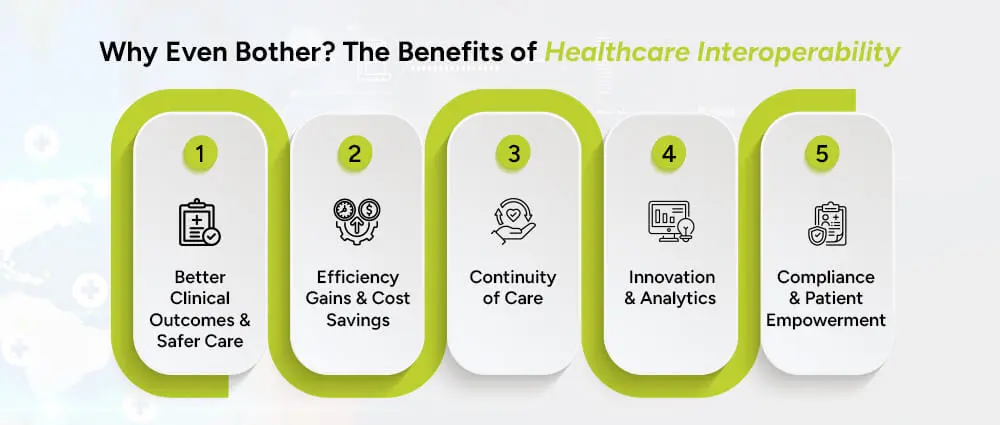
If building integration sounds like a lot of work (and it is!), why do it? The benefits are compelling and when you outsource the healthcare support services, the benefits that they provide you are even better:
When the providers are able to get a patient’s complete medical history, medications, allergies, lab results, imaging, and so on, from any facility, clinical decisions are really more informed. That implies fewer mistakes, fewer tests that have been done already, and quicker interventions.
Organizations can save both time and money by eliminating duplicate tests, reducing administrative drag, and cutting data re-entry. Interoperability not only hurries up the workflows but also allows the workers to look after the patients and not to run after the documents.
Patients are often visiting various clinics, hospitals, laboratories, radiology centers, specialists, etc. When all the points in that chain are enabled to communicate and access patient data, care transitions are made less troublesome and, thus, more secure.
Data can be accessed freely, hence you can also add analytics, AI, population health tools, predictive modeling, and the like. Richer data justifies smarter insight if the systems are interoperable.
Most of the regulatory frameworks today require or at least encourage interoperability and patient data access. Furthermore, the interoperable systems give patients the power to see, share, or even contribute to their own records across different platforms.
Here’s a reality check: as of 2023, 70% of U.S. hospitals engaged in all four key domains of interoperable exchange (send, receive, find, integrate), a big increase from prior years.
And in 2021, 88% of hospitals were electronically sending or obtaining patient health information, and nearly 3/4 were integrating that data into their EHRs.
That said, adoption still isn’t universal, and many smaller or rural hospitals lag behind. The value is clear, but the path isn’t always easy.
Let’s get honest: making interoperability happen is hard. Some of the key hurdles include:
The various healthcare institutions still rely upon outdated systems or particular software that was not designed to ensure interoperability. The vendors usually rely on their own proprietary protocols thereby complicating the integration further.
Even if the systems are compliant with HL7 or FHIR, the differences in implementation, the use of optional fields, or the interpretation of the underlying meaning can bring about mismatches. The standards are really strong, but still they allow for deviating practices.
Sharing data may not be acceptable to some departments or institutions, due to privacy fears, competition for incentives, or data ownership issues.
The process of sharing health data is very demanding in terms of security, encryption, identity controls, and patient consent. Moreover, you have to ensure that you comply with the laws such as HIPAA compliance, GDPR, or local health data acts.
Building interoperable systems requires investment, not just in software, but in integration, mapping, testing, maintenance, and governance. For example, integrating a medical device to an EHR might cost thousands per unit and carry ongoing maintenance expenses.
It’s not enough to send a field called “blood pressure”; systems must agree on units, codes, and interpretation. Semantic alignment and ontology mapping are intricate tasks.
Despite the challenges, it’s precisely the organizations that take interoperability seriously and invest in robust healthcare interoperability software and solutions that will create sustained value.
What does a real-world interoperability solution look like? Below are some of the tools and approaches you can adopt (or look for in a software partner):
These act as translators, receiving HL7 v2 messages (e.g. lab results, ADT events) and routing them to appropriate systems or transforming them for compatibility.
FHIR (a standard under HL7) offers APIs for reading, writing, and querying medical data resources (Patient, Observation, Condition, etc.). Middleware platforms help unify data flows across legacy systems.
It connects different systems through adapters at one central point and also manages the data interchange in common formats.
Networks that could be either at the regional or national level and that make it possible for data to be exchanged between different organizations.
Makes sure that every patient is given a unique identifier across different systems, thus preventing the occurrence of duplicates or errors.
Convert the various coding systems used (for instance, SNOMED, LOINC, ICD) into one another so as to allow for semantic interoperability.
For governance, audit trails, encryption, and enforcing patient permissions or consent flags to minimize cybercrimes.
Once data is flowing, you can feed it into deeper layers for insights, AI, or reporting.
When your software solution combines multiple of these capabilities in a modular, secure, scalable way, with seamless EHR integration, that’s when you get real leverage. We build precisely such architectures, healthcare interoperability software that bridges gaps rather than reinforcing them.
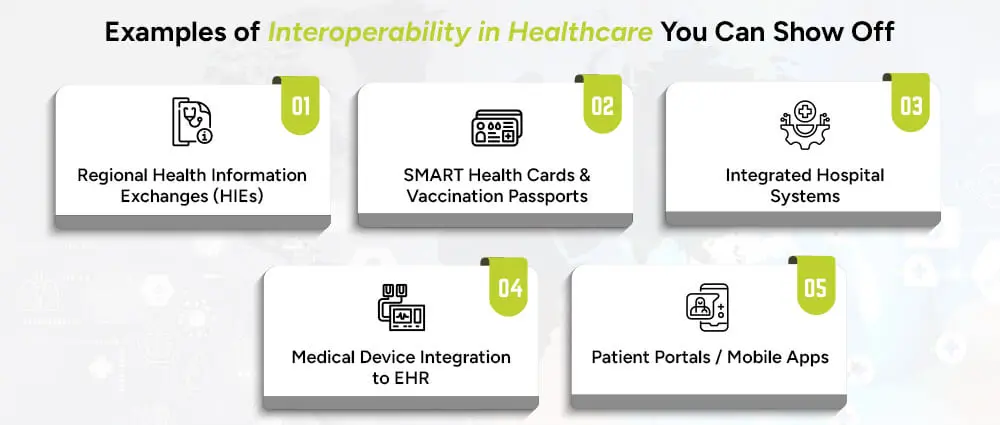
Here are a few compelling, real-world examples:
An HIE connects hospitals, labs, imaging centers, pharmacies, and clinics in many areas. In addition to that, doctors can make queries and get patient summaries from other institutions that are part of the program.
The COVID-19 pandemic brought about the need for digital vaccination records that could be verified cross-site, using HL7 FHIR and W3C frameworks, and thus the standardization of digital records was established.
A doctor’s EHR sends a patient’s laboratory orders to the laboratory’s system; results are then automatically read and added to the patient’s record without any human intervention.
The EHR receives streaming data from a ventilator, ECG machine, or infusion pump; the clinicians can monitor and notify them on one dashboard.
Patients have access to their records, lab results, or vaccination history and can even share that information with another provider, regardless of institutions and platforms.
Each of these examples is more than just cool tech, they translate isolated records into actionable care.
Here’s a suggested roadmap to make interoperability a reality (and not just a buzzword).
Map out systems, data flows, silos, standards. Use an interoperability maturity model (e.g. HIMSS) to benchmark.
What data is critical to exchange (labs, imaging, medications)? Which workflows suffer most from silos?
Align on HL7/FHIR, messaging protocols, API design, and vendor-neutral integration.
Look for modular, scalable interoperability frameworks. Look for healthcare solutions that are built this way!
Start with limited exchanges (e.g. lab to EHR), test mappings, data quality, consent flows, security controls.
Create a policy framework around data ownership, consent, versioning, and semantic semantics.
Add new systems, institutions, device integrations, and analytics layers. Monitor and refine.
If you follow this path and choose the right healthcare interoperability solutions, you’ll convert isolated silos into value-generating networks, benefiting providers, patients, and administrators
Interoperability in healthcare is not only a technical upgrade, it is a total shift towards care that is smarter, safer, and connected. The communication between hospitals, labs, and digital platforms without any effort ensures that the healthcare process is fast, reliable, and patient-centered. However, the achievement of this level of flawless connectivity requires the perfect technology partner, one who is fully aware of both the integration of EHRs and the challenges of data exchange in healthcare on a practical basis.
We at Arpatech, a company specializing in providing healthcare interoperability software, help overcome the data silos issue, support the HL7 and FHIR standards, and allow the secure and smooth flow of data across your systems. Our team is capable of providing you with the customized healthcare interoperability solutions, API development, or complete integration of your existing platforms that you need and also helping you design a scalable ecosystem that changes the way your organization delivers care.
Let’s build connected healthcare together. Get in touch with Arpatech today to discover how interoperability can unlock the full potential of your data.
Interoperability, in simple terms, aims to turn scattered data into a unified clinical story. Due to the complexities and multi-institutional nature of healthcare, it is not possible for a single system to contain everything. If interoperability is not in place:
However, if there is proper interoperability, you will have safer, faster, and smarter care.
This is a useful framework to understand how deep your connectivity is. The three main types are:
The ability of systems to pass data back and forth, wiring, protocols, message formats. For example, an HL7 v2 message moving from Lab System A to EHR B.
Ensuring that the receiving system can interpret that data in the same way the sender intended, for instance, anemia coded the same way, units matched, terminology aligned. It’s about shared meaning, e.g. SNOMED, LOINC, standard terminologies.
Aligning workflows, policies, consent, permissions, responsibilities across institutions. It involves governance, data ownership, authentication, business rules. Even if two systems speak the same language, they need agreements about who’s allowed to fetch what, when, and how.
When all three are working, you have truly interoperable healthcare, not just data passing, but data that leads to action.
Ramsha Khan
Oct 14, 2025

Digital Wallets Beyond Fintech Payment Solutions
If you’ve been keeping up with the world of finance and technology, you already know that fintech payment solutions are changing the way we handle money. But this is really thrilling: digital wallets do not really just pay bills for you, or tap your phone at the register to buy a cup of coffee, or have friends split a bill with you. They are quite steadily evolving into powerful tools that go way beyond payment solutions.
Today, digital wallets are at the very base of a transformation that can be anything from real-time payments to open banking and mobile banking experiences. These tools will take businesses, consumers, and even states toward a new level in their journey toward innovation in the payment arena.
Here, we’ll explore how digital wallets are redefining financial ecosystems, why they matter to industries outside traditional finance, and what the future holds for them.
When people first heard about digital wallets, most thought of them as a simple alternative to credit cards or cash. Apple Pay, Google Wallet, and PayPal dominated the scene, showing us how easy it could be to complete transactions digitally. But now, digital wallets are turning into something much more: lifestyle companions.
Think about it: today, your wallet can hold not just money but also loyalty points, airline tickets, event passes, and even your digital ID. Instead of being just a transaction tool, it becomes your gateway to everyday experiences.
One of the most groundbreaking changes digital wallets bring is real-time payments. No more waiting hours or days for money to show up in your account. Whether you’re sending money across borders or paying a freelancer in another country, digital wallets make it instant.
According to Statista, the global transaction value of digital payments is expected to reach $14.79 trillion by 2027. This number reflects just how big the demand for fast, convenient, and reliable solutions has become.
For businesses, real-time payments through digital wallets mean better cash flow and smoother supply chains. For consumers, it’s about speed and trust; you know your money will arrive when you need it.
Another way digital wallets are availing one of the integrations applications in collaboration with mobile banking. Banks do not suffice in holding your funds only, but actually contest against one another to create more seamless tech-enabled experiences.
Suppose this application allows you to log into your bank account, view your digital wallet’s remaining balance, transfer funds instantly, and explore personalized financial advice all in one place. Customers enjoy it, and banks remain relevant in this fintech world.
Just look at the numbers: mobile banking, in 2024, was adopted for use by more than 55% of the people in the U.S. You take that and add in growth figures from digital wallets, and one gets a good glimpse into the future-much of it connected and mobile-first.
Here’s where things get even more exciting with open banking. At its core, open banking allows financial data to flow securely between banks, enables fintech apps security, and third-party providers. Digital wallets are at the forefront of this revolution.
With open banking, your digital wallet could do things like:
This level of personalization turns digital wallets into financial advisors in your pocket. For businesses, it opens doors to new services, better customer insights, and partnerships with innovative fintech providers.
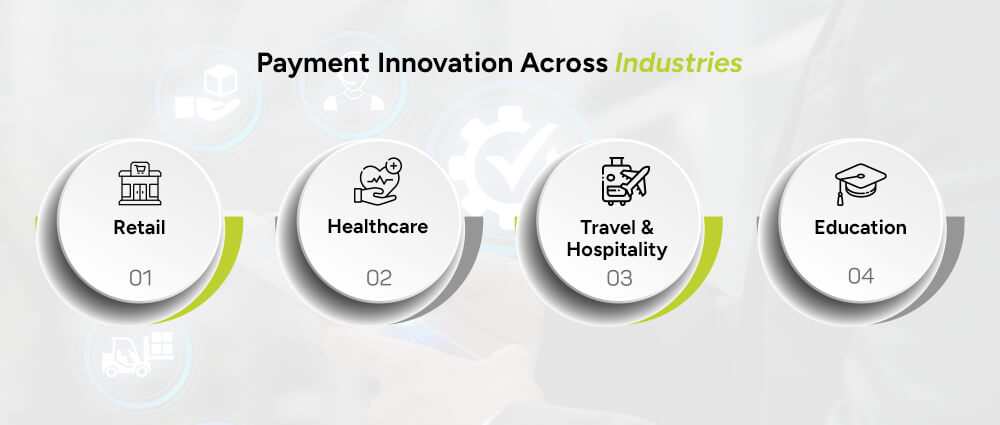
The beauty of digital wallets is that they’re not limited to financial transactions. Let’s look at how industries outside banking are using them:
Through loyalty rewards and personalized promotions, retailers are incorporating digital wallets into shopping apps. Customers enjoy instant discounts while brands cultivate a stronger bond.
Secure digital wallets enable patients to store insurance information, pay bills, and even handle prescriptions.
Digital wallets eliminate cumbersome routines with boarding passes, hotel check-ins, and car rentals.
Universities are testing wallets for fee payments, ID cards, and access to campus services.
This cross-industry adoption shows that payment innovation isn’t just about money, it’s about convenience and trust across daily life.
If you’re running a business, ignoring the rise of digital wallets isn’t an option. Customers now expect real-time payments, seamless checkouts, and integrations with their favorite wallets. By offering these options, you:
And here’s the twist: businesses that adapt to payment innovation early don’t just survive, they thrive. They attract younger, tech-savvy customers while streamlining internal processes.
This is exactly where our digital software solutions come in. We help businesses create, integrate, and scale digital wallet experiences personalized to their industry. Whether you need a custom wallet for retail, a mobile banking upgrade, or an open banking integration, we’ve got the expertise to make it happen.
So, what’s next for digital wallets? The possibilities are endless. We’re moving toward wallets that:

The line between finance and everyday life will blur even further. Soon, your digital wallet won’t just handle money; it’ll manage your entire digital existence.
Digital wallets are no longer just about making quick payments at the grocery store. They’ve evolved into dynamic ecosystems that combine fintech payment solutions, mobile banking, real-time payments, open banking, and payment innovation.
For businesses, this means a chance to get ahead by offering customers smarter, faster, and more connected experiences. For consumers, it means more control, convenience, and trust.
If you’re ready to explore how digital wallets can transform your business, at Arpatech, our digital software solutions are here to guide you every step of the way. Let’s shape the future of payments together.
A digital wallet payment refers to payments done using an electronic gadget, usually a smartphone, which stores securely the payment data for credit cards, debit cards, or bank accounts. This method permits fast payment with little hassle of carrying actual cash and cards.
Convenience is the greatest benefit. You can pay instantly, track your expenses, and even have a place to store your rewards or tickets-all in the same secure place.
The next-generation payment solutions symbolize a revolution where real-time payments, sharing banking APIs, AI-enabled customization, and digital wallets are implanted with one another to offer a more progressive, safe, and smart financial experience.
Payments edition of the future headlines in digital wallets, integration with mobile banking, real-time payments, open banking functionalities, and blockchain-performance-powered transactions. These technological wins are revolutionizing debentures in tomorrow’s finance from various domains.
Ramsha Khan
Oct 9, 2025

Insurance Fraud Prevention with Blockchain and AI
Insurance is built on trust. People pay premiums with the belief that their insurance company will step in during tough times, whether it’s after a car accident, a hospital stay, or damage to their home. But unfortunately, fraud eats away at this trust. Insurance fraud is a growing phenomenon across the globe tolling up dollars in billions every year while raising premium costs for honest customers.
Luckily, new things like Blockchain and Artificial Intelligence (AI) technologies have changed the game really quite well. All of these really powerful technologies are changing the way we detect, prevent, and even eliminate fraud in the insurance industry. Let’s explain how this works and why it matters.
Insurance fraud isn’t just about a few fake claims here and there; it’s a massive global issue. According to the Coalition Against Insurance Fraud, fraud costs the U.S. insurance industry over $308 billion annually. That’s money that could have gone into lowering premiums, improving services, or creating more customer benefits.
Fake medical bills, staged vehicle accidents, padded property claims, or even people taking insurance policies under fraudulent names are all forms of fraud. Every time fraud occurs, the investigator spends considerable time and energy to investigate it, and customers usually feel the consequences through higher costs.
Here is where Insurance Fraud Prevention, Blockchain, and AI step in for insurance fraud detection. Together, they offer transparency, speed, and intelligence that no human investigator can match by themself.
Let us define what the term actually means before digging deep into the nitty-gritty of how blockchain fights fraud.
Blockchain is like digital ledger, or book of records that keeps track of transactions. But here comes the twist: Unlike the traditionally maintained records, blockchain does not exist at one point; it is on many computers; once the information enters it, it cannot be changed or altered.
What does that mean for insurance companies?
So really, a person would think of blockchain as a glass with clear visibility where every action can be traced and traced and locked.
While blockchain locks down data, AI in insurance fraud prevention brings intelligence to the table. Artificial Intelligence thrives on analyzing large volumes of information quickly, something human teams would take weeks or months to do.

AI uses tools like machine learning, natural language processing, and predictive analytics to:
In short, AI works like a detective, always scanning the scene, connecting the dots, and raising red flags where things don’t add up.
Blockchain and AI, when taken separately, are great. Together, however, the two form a chain that cannot be broken when it comes to preventing fraud in insurance.
Here is how they complement each other:
For example: consider a situation wherein one claimant attempts to lodge duplicate claims for the same car accident with two different insurers. Blockchain ensures that both claims are posted on the same ledger and, hence, duplication is quite apparent. Further, AI flags the duplicate instantly and saves both insurers time and money.
Let’s bring this down to real-world scenarios where these technologies are already making a difference.
Fake medical bills are one of the biggest sources of fraud. Blockchain ensures hospital records are securely stored and can’t be altered. AI then checks these records against submitted claims to verify authenticity.
Some fraudsters stage accidents or inflate repair costs. AI can analyze crash photos or repair bills to detect inconsistencies, while blockchain ensures repair shop records match what’s being claimed.
False identities are sometimes used to file fraudulent claims. With blockchain, identity verification becomes foolproof, while AI checks application patterns to catch suspicious submissions.
These examples highlight how risk assessment blockchain systems combined with AI can filter out fraud before it even reaches the payout stage.
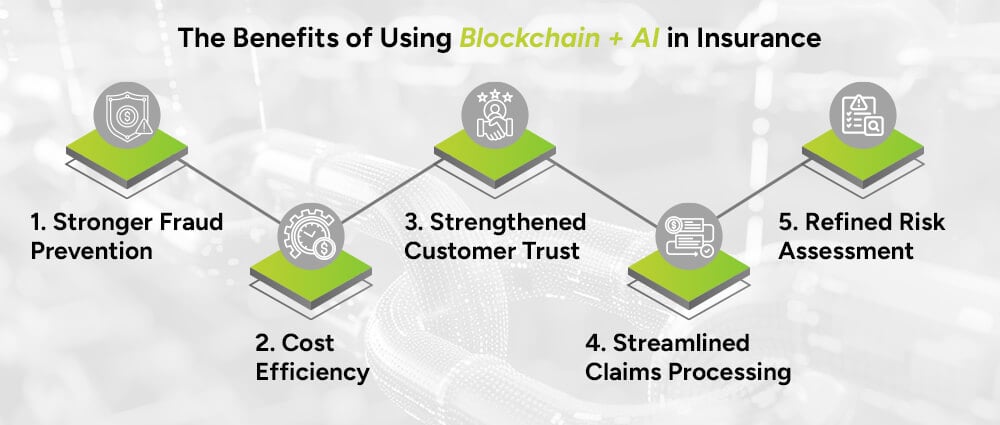
So, why should insurance companies adopt these technologies? Here are some clear benefits:
The combination of blockchain’s tamper-proof records and AI’s ability to analyze data in real time creates an airtight defense system.
Insurance companies are able to save billions in their operations through fraud reduction, which can be channelled to either reduce premiums or uplift the service levels offered to customers.
The customers develop confidence because they believe their data is safe and that their insurer is employing cutting-edge tools to ensure fairness.
From the time that the blockchain holds the accurate data to the validation of the claim down to payment by the intelligent system, the customer no longer has to wait for weeks for investigations.
Risk assessment blockchain systems guarantee that insurers are able to accurately assess those risks by looking at clean and credible data. Fair pricing equates to fewer mistakes.
Of course, like any new technology, adopting blockchain and AI isn’t without challenges.
But despite these challenges, the long-term benefits make adoption worthwhile. In fact, many insurers are already running pilot projects to see how blockchain and AI can reshape their fraud prevention strategies.
The future looks promising. As blockchain networks grow and AI algorithms get smarter, insurance fraud prevention will become more efficient, accurate, and reliable. Imagine a world where fraudulent claims are spotted instantly, honest customers get faster payouts, and insurers save billions every year.
This isn’t science fiction; it’s already happening. In the next decade, blockchain security insurance solutions and AI-driven fraud detection systems will become standard practice across the industry. And that’s where Arpatech comes in, by helping insurers design, build, and integrate customized blockchain + AI solutions, ensuring stronger fraud prevention, better data integrity, and smarter risk assessment for long-term success.
Deception is a disaster, and you need disaster recovery as soon as possible. Blockchain and AI can help prevent several types of fraud, including:
Blockchain ensures that all data is secure, transparent, and tamper-proof, while AI analyzes that data to spot suspicious behavior. In other words, blockchain provides the trustworthy foundation, and AI acts as the smart detective. Together, they create a reliable system for detecting and preventing fraud.
Risk assessment improves because blockchain provides accurate, unaltered records, and AI uses that clean data to predict risks more effectively. For insurers, this means more accurate pricing, better decision-making, and fewer chances of fraud slipping through the cracks.
Ramsha Khan
Oct 7, 2025

Blockchain’s Role in Insurtech Data Integrity
Insurance lives and dies on trust. Policyholders trust carriers to keep accurate records, pay legitimate claims, and protect sensitive data. Insurers trust each other, brokers, and regulators to be honest and auditable. Insurtech, technology that modernizes insurance, has already changed how companies price risk, process claims, and serve customers. But one of the most powerful tools in the insurtech toolbox for strengthening data integrity is blockchain.
Below, we’ll walk you through, in plain language, how blockchain adds real value for insurers: from immutable records and smart contracts to fraud prevention, claims automation, and meeting regulatory compliance needs. We’ll use simple examples, touch on practical limits, and close with answers to the most common questions.
At its simplest, data integrity means data you can trust: complete, accurate, tamper-evident, and auditable. For insurance, that means:
Traditional systems store this data in centralized databases. That works, but it creates single points of failure, reconciliation headaches when multiple parties are involved, and opportunities for fraud or accidental changes.
A blockchain (or distributed ledger) is a shared database where transactions are recorded in an append-only chain of blocks. Two important features for insurance are:
When insurers, reinsurers, brokers, hospitals, and regulators agree to share certain data on a permissioned ledger, everyone gets the same view of truth. That’s hugely helpful for transparency, digital trust, and risk management.
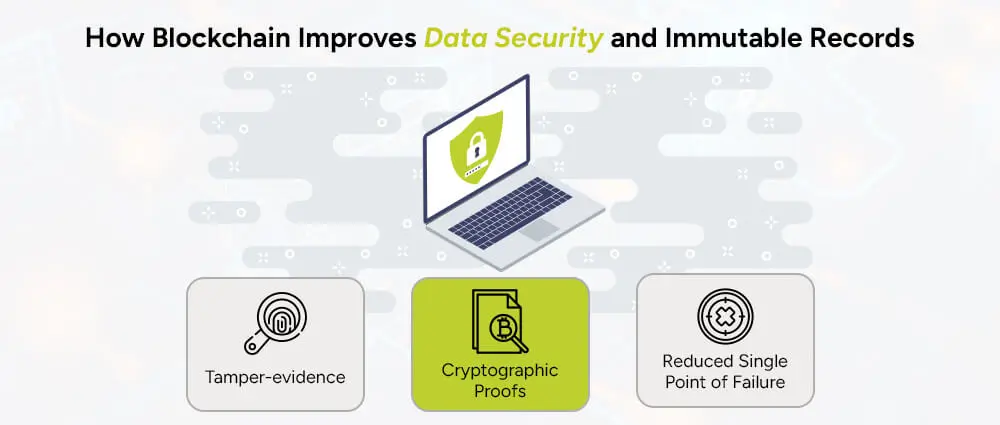
Blockchain helps data security in three practical ways:
Edits to records are visible because each new block references the previous one. If someone tampers with old data, the chain won’t validate across the network.
Entries are cryptographically signed, so you can cryptographically verify who added what and when.
With permissioned blockchains, multiple trusted parties host nodes, reducing the risk that one compromised system ruins the whole dataset.
Put together, these features create immutable records that auditors and regulators can rely on. That’s not the same as making everything public; permissioned ledgers can still restrict who sees what while preserving integrity.
One thing to remember: blockchain strengthens integrity but does not replace the need for good access controls, encryption of sensitive fields, and secure key management.
One of the most practical Insurtech applications is combining blockchain with smart contracts, small programs that run on the ledger and execute when preset conditions are met.
Imagine a travel delay policy: if flight delay data (from a trusted oracle) shows a qualifying delay, a smart contract automatically triggers a claim payment to the policyholder. That’s claims automation with fewer manual steps, fewer disputes, and faster payouts.
Smart contracts must be carefully written and tested; bugs here can cause wrong payouts or stuck claims, so governance and fallback processes are critical.
Fraud is responsible for costing insurers billions every year. Blockchain will discourage such fraudulent acts by making it easy to spot duplicate claims, staged events, or inconsistent histories:
Regulators want clear, auditable trails. Blockchain naturally supports auditability by recording who did what and when. Permissioned ledgers make it possible to:
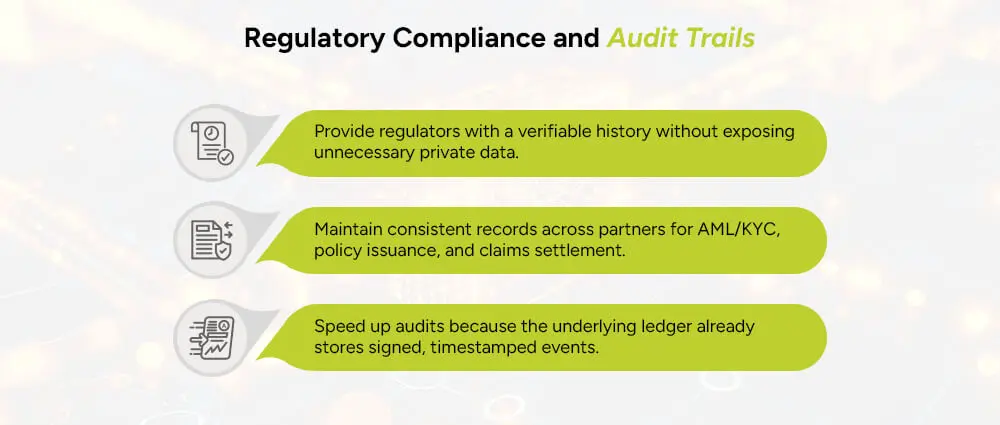
This doesn’t remove the need for legal and compliance teams, but it streamlines audits and improves regulatory compliance readiness.
Some real-world use cases that benefit most:
Industry research also shows growing interest: market forecasts project strong growth in blockchain use within insurance, as companies invest in verification, reconciliation, and automation tools. For example, one market analysis projects the blockchain-in-insurance market to expand significantly over the coming years. Many insurance firms report plans to increase blockchain investment as they target claims automation and fraud prevention.
Blockchain isn’t a silver bullet. Here are practical limits to consider:
Good implementations mix blockchain with proven engineering practices: off-chain storage for heavy or private data, signed hashes on-chain for integrity, and clear legal agreements among participants.
Technology alone doesn’t create trust; people do. Blockchain is a tool that makes it easier to prove things to customers, partners, and regulators. Pair it with transparent governance, strong security practices, and user-friendly interfaces, and insurers can deliver real digital trust to customers.
To successfully implement blockchain, insurers should identify various applications but zero in on a high-value, focused use case for entering the blockchain space, such as claims handling. Sensitivity regarding information requires using permission ledgers, which enable storing on-chain only cryptographic proofs. Key elements needed for success include strong governance, reliable identity framework, trusted data oracle, but above all, a pilot with key partners like brokers, reinsurers, or hospitals to get the real value out of network collaboration.
At Arpatech, we help businesses navigate this journey by designing blockchain solutions tailored for insurance, ensuring data integrity, regulatory compliance, and seamless integration with existing systems, so you can build trust, reduce risk, and innovate with confidence.
It stores signed, timestamped entries in purely append-only ledgers, rendering records tamper-evident and readily verifiable by various parties. In combination with on-chain hashes and off-chain secure storage for private data, one can obtain both privacy and integrity: the ledger proves, without revealing any sensitive content, that data did exist at a certain state.
Yes, they really do. The audit trails created by blockchains show who has entered data and the time. Permissioned ledgers allow insurers to build access for regulatory purposes to verifiable data without publishing customer details publicly. That gives rise to faster audits and lesser work during reconciliation. It should be noted that it must be supplemented with proper governance and privacy practices to be able to satisfy legal requirements.
Top beneficiaries include:
Ramsha Khan
Sep 30, 2025